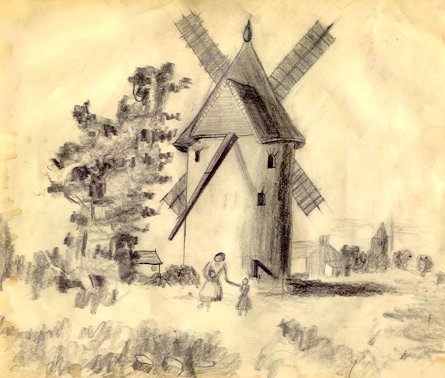The Wind
Today, wind and the medieval mind. The University of Houston's College of Engineering presents this series about the machines that make our civilization run, and the people whose ingenuity created them.
What do you suppose a medieval miller thought it was that caused the wind to drive his mill? What invisible efficacy rode in the air to grind his grain? The wind still captures our imaginations, even when we know about air, kinetic energy, and force balances. What must it have meant when people knew none of that?
The ancient languages offer a remarkable answer. All of them used the same word for wind, for breath, and for soul. In Sanskrit that word is atman; in Latin it's either spiritus or anima; in Hebrew it's ru-ach; and in Greek it's pneuma. You find pneuma and spiritus in air-related words like pneumatic and respiration. Atman shows up again as the German verb atmen which means to breath and ru-ach is probably kin the the German word rauch, for smoke. The Russian word for spirit, duh, has many wind-related cognates. Duhovyia intrumenti, for example, means wind instruments.
The connection is that both the wind and the soul were the breath of God. Genesis begins with God breathing a soul into Adam, and medieval engineers saw nothing less blowing their windmills. The power source was mystical. Indeed, some historians suggest that power-producing windmills evolved out of ancient Buddhist prayer wheels, which were spun by sail-like propellers. And, in that sense, spiritus may have preceded power.
By the early nineteenth century, we understood the wind in technical terms; but it'd lost none of its metaphorical power. Listen to these words from Percy Shelley's Ode to the West Wind:
. . . Be thou, Spirit fierce,
My spirit! Be thou me, impetuous one!
Drive my dead thoughts over the universe,
Like wither'd leaves, to quicken new birth.
Of course, Shelley's wind was more than just spiritus. It was a renewing spirit, a cleansing new broom. That's the same imagery we use when we tell each other, "It's an ill wind that blows no good."
The world is girdled with prevailing winds. Shelley's westerlies prevail in a band around the 45th parallel. That's why New York is two hours farther from London by air than London is from New York. Below the westerlies are trade winds. The trade winds are bounded by two bands nearly devoid of wind. Above are the "horse latitudes" (so called because horses on ships becalmed in that region were often killed to save water). On the equatorial band below the trade winds are the doldrums, a word that also means dis-spirited.
Today the wind again rises as a power source. Stand in the midst of one of the new windmill farms, and you can feel pneuma, atman, and spiritus driving our dead thoughts "like wither'd leaves, to quicken new birth." Windmills won't be the final answer to our energy needs. But they do remind us to see mystery within reality, even as our medieval forebears did. For no useful answer to any problem as ancient as energy supply will ever arrive without bearing a dimension of surprise, rebirth, and spiritus.
I'm John Lienhard, at the University of Houston, where we're interested in the way inventive minds work.
(Theme music)
This is a greatly revised version of Episode 107.

The Wind -- a kid's eye view
Who has seen the wind?
Neither I nor you.
But when the leaves hang trembling,
The wind is passing through.
Who has seen the wind?
Neither you nor I.
But when the trees bow down their heads,
The wind is passing by.Who Has Seen the Wind?
Christina Rossetti